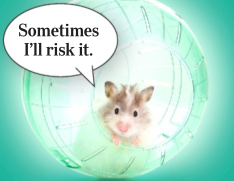Parrots. 36 I mimic humans well because I'm good at copying other parrots.
我很會模仿人類,因為我擅長模仿其他鸚鵡。
In the wild, parrots live in large, cohesive groups and squawk constantly,
在野外,鸚鵡生活在大的,緊密團結的群體中,而且經常尖叫,
updating one another on where the best seeds are and which direction to search next for food.
互相告知最新的種子在哪里,接下來去哪里尋找食物。
Timothy F.Wright, coauthor of Parrots of the Wild: A Natural History of the World's Most Captivating Birds,
蒂莫西·F·賴特是《野生鸚鵡:世界上最迷人的鳥類的自然史》一書的合著者,
told the New York Times that it's rare for wild parrots to mimic sounds made by other species.
他在接受《紐約時報》采訪時表示,野生鸚鵡能夠模仿其他物種發出的聲音是很罕見的。
But in captivity, they'll mimic barking dogs, car alarms, and human speech in an attempt to bond with their human flock.
但是在圈養下,他們會模仿狗叫,車鳴,還有人類講話,試圖和人類建立聯系。
Hamsters. 37 I can learn to take risks.
我可以學會冒險。
A 2015 experiment found that hamsters whose cages had received fancy upgrades (extra bedding, chew toys, a tent) were more inclined to take a risk:
2015年的一項研究發現,如果倉鼠的籠子升級了(額外的床上用品、咀嚼玩具、帳篷),它們就更愿意冒險:
drinking from a new water dispenser when they didn't know whether it contained a sweet or a bitter liquid.
在不知道新的飲水機裝的是甜的還是苦的液體的情況下喝里面的水。
Hamsters whose upgrades were replaced with cardboard tubes and squeaky wheels, on the other hand,
另一方面,籠子里換上硬紙板管和吱吱作響的輪子的倉鼠,
were less likely to go for it—seemingly figuring that they couldn't expect nice things in life.
不太可能去喝里面的水,似乎發現了它們不會期待生活中的好東西。
Horses. 38 I can gauge your mood. A study in Biology Letters showed that horses can tell the difference between happy and angry human expressions.
我能判斷你的情緒。《生物學報》的一個研究顯示,馬能區分人類高興和生氣的表情。
When they looked at photographs of people making negative faces,
當他們看到人們做負面表情的照片時,
their heart rates climbed and they turned their heads to allow themselves to focus with their left eye.
它們會心跳加速,扭頭讓自己的左眼集中注意力。
Researchers think this "left-eye gaze" happens because the right hemisphere of the brain is better at processing negative emotions.
研究人員認為,這種“左眼注視”會出現是因為,大腦的右半球能更好地處理負面情緒。
Horses are not alone in this skill: A 2016 study found that
不止是馬有這個技能:一項2016年的研究發現,
dogs could tell from photos of human facial expressions and recordings of voices whether the person in question was happy or mad.
狗能從人類面部表情的照片和錄音中分辨出這個人是高興還是生氣。

(They can read the faces and vocalizations of other dogs too.)
(他們也能閱讀其他狗的面孔和聲音。)
39 And I remember you were mad the last time I saw you.
我記得上次見到你時你很生氣。
In another study, several hours after horses were shown photographs of people with happy or angry expressions,
在另一項研究中,研究人員向馬展示了人的快樂或憤怒表情的照片幾個小時后,
those same people visited the horses in person, wearing neutral faces.
同樣是這些人,帶著中立的表情,親自去見了這些馬。
If a horse had previously seen an angry-looking photo of that person,
如果一匹馬之前看到過那個人的憤怒的照片,
it exhibited a left-gaze bias and showed other signs of stress, including scratching the floor.
它就會表現出左視傾向,并表現出其他壓力表現,包括抓地板。
But horses visited by people who were happy in the photos weren't stressed at all.
但是當馬看到照片中是高興表情的人時,它們不會表現出絲毫緊張。



